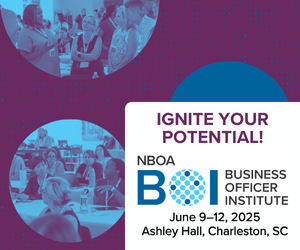
NBOA President and CEO
Those of you working in the independent school business office have dealt with the technological requirements for distance learning, considered the deep cleaning of campus facilities, read the fine print on government loan programs and more. We have done our best to keep our communities physically safe from the new disease. But there is a more human aspect of managing our response to the COVID-19 pandemic — the mental wellness of our employees.
While this may be top of mind for human resources professionals, I, as perhaps some of you, have admittedly given it less thought than other matters amid the frenzy of this time. As we talk about getting to the “next normal,” we would all do well to consider how our administrators, teachers, aides and staff can care for themselves and thereby better care for students upon their return.
As we talk about getting to the “next normal,” we would all do well to consider how our administrators, teachers, aides and staff can care for themselves and thereby better care for students upon their return.
In a recent Forbes article, human resources leader Michael Bertolino described a pre-pandemic world where workplaces already played an outsized role on employees’ mental health. He noted that one in five U.S. workers will suffer from mental health problems in their lifetime. Given that about a third of our lives is spent in our workplaces, we have a responsibility to consider this important aspect of our communities’ health.
We can argue that independent schools provide some of the most attractive workplaces in the country. In fact, quality of life is one of our best recruitment tools; the learning communities of students, faculty and administrators are a joy to be a part of. But like other workplaces, we’re facing the new challenge of a long-term disconnect from each other and our usual work enviornments.
As Bertolino said, technology has been “a critical enabler – not just of operations, but of connectivity between individuals” to help bridge the tremendous gap many of us are experiencing. Like other organizations, NBOA has been using technology to mitigate these potential feelings of disconnectedness. We have increased the frequency of all-staff check-ins, for example, and made time for a discussion about wellness. And I have encouraged staff to be mindful of their vacation leave and consider taking time off even while travel is difficult.
The larger point for our schools is to help ensure that we are ready, able and mentally prepared to welcome students back in the fall. NBOA’s director, human resources, Amber Stockham, SPHR, offered this additional advice: “Consider bringing in trauma counselors to work with faculty and staff as they return to campus. We can expect trauma in our students, and most schools are working right now to address the mental health challenges that will present among the student body in the fall. However, this has been a traumatic event for your adult community too, and those who are exercising appropriate self-care and working through their lived experiences of the last three months will be best prepared to help their students succeed.”
“Studies have found time and again that when people feel their mental health is supported, their commitment to their employer rises, as does their productivity, engagement and numerous other factors,” wrote Bertolino.
Whether we come together virtually or face-to-face in the coming months, we need to be at the top of our game, and this demands that we consider what we are doing to support our most valuable resource – our independent school faculty and staff.





